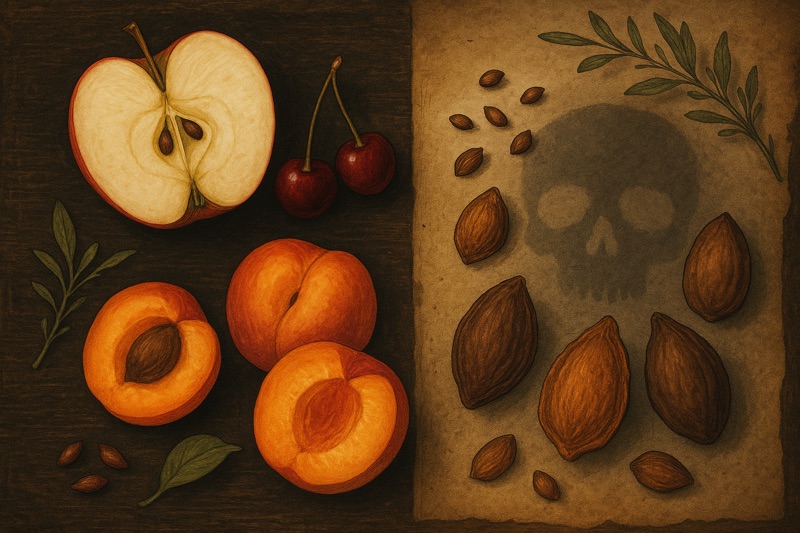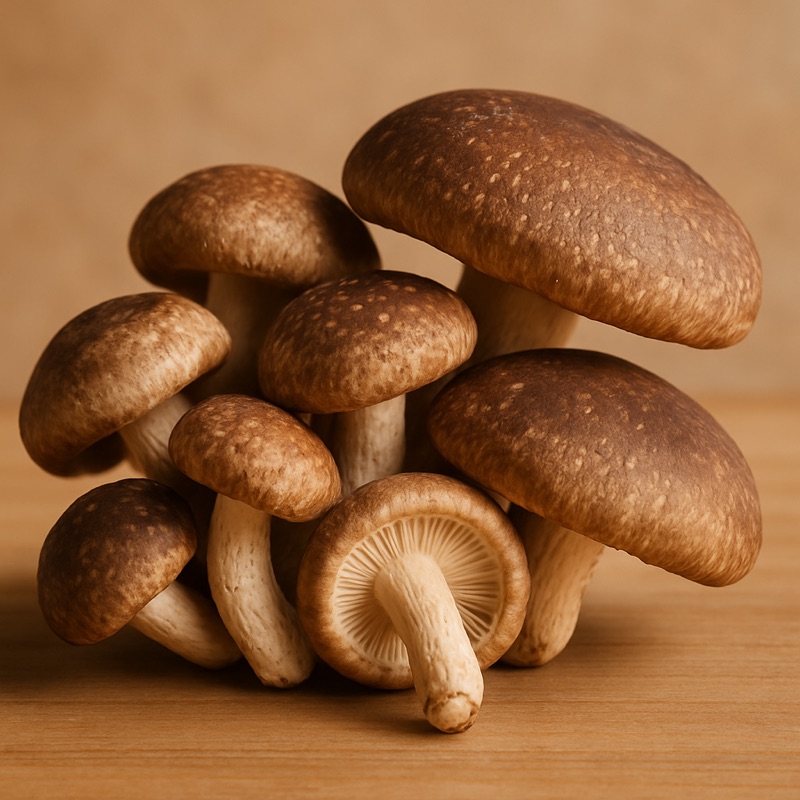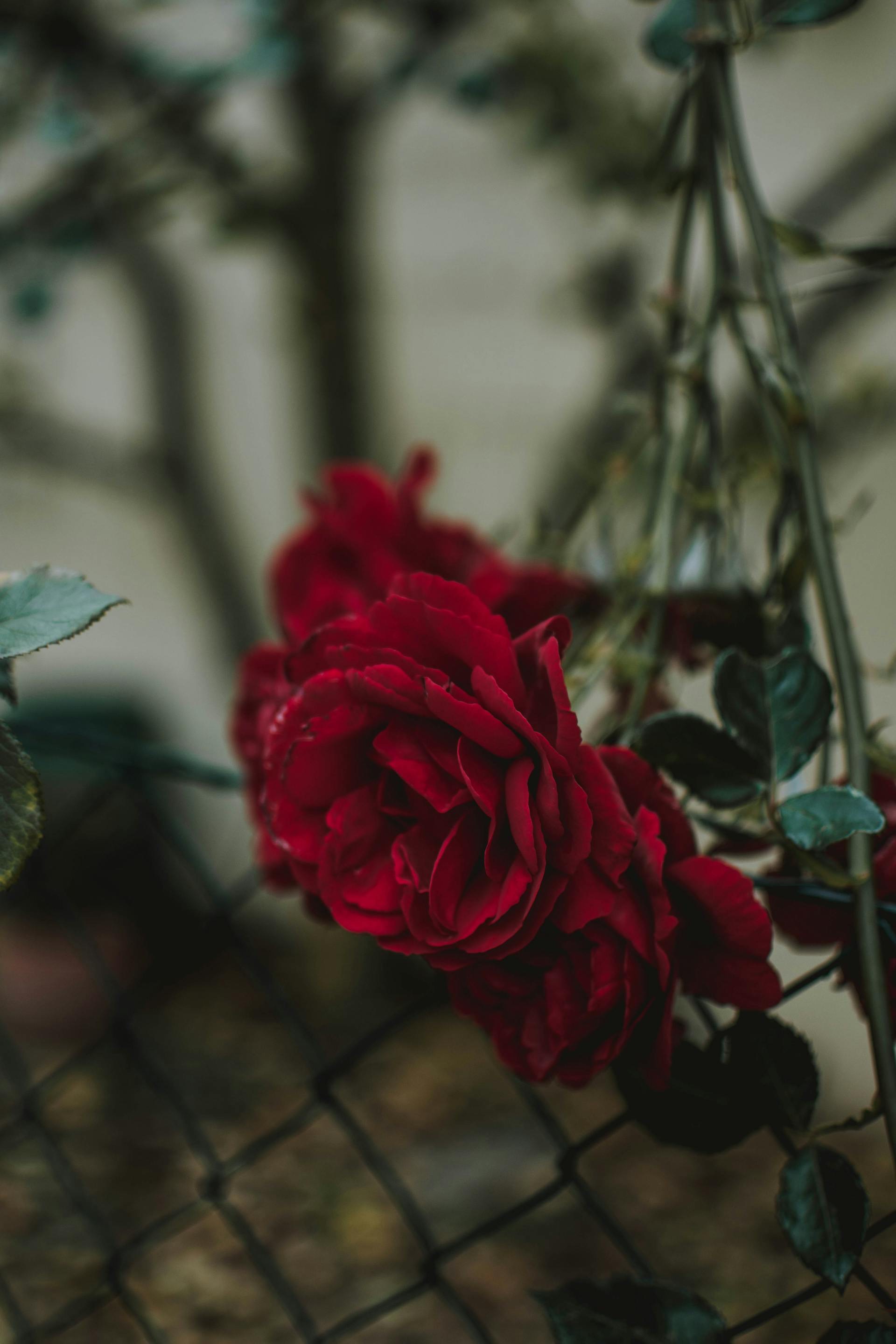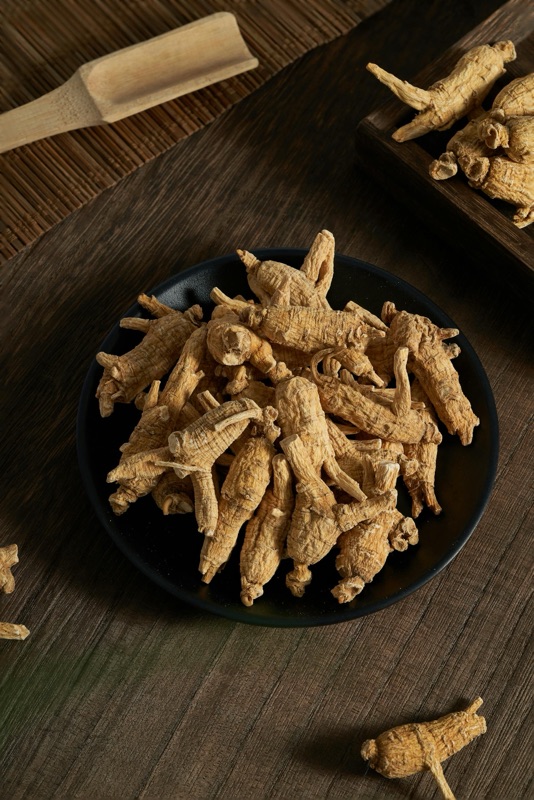Botanical Basics
- Common Name(s): Potato, Irish potato, white potato
- Folk Name(s): Taters, spuds, earth-apples
- Scientific/Latin Name: Solanum tuberosum
- Family: Solanaceae (Nightshade family)
- Plant Type: Cool-season, frost-tender perennial grown as an annual for its underground tubers
- Botanical Description: Erect to sprawling plant 1–3 ft (30–90 cm) tall with compound leaves and white/pink/purple, star-shaped nightshade flowers. Forms stolons underground that swell into starchy tubers (“potatoes”). Produces marble-sized green berries (seed balls) that are not edible and contain high glycoalkaloids.
- Growing Zones/Climate: Widely adapted; best in cool climates. Successfully grown as an annual in most regions (approx. USDA 3–10 with seasonal timing).
- Best Zones for Growth: Cool summers or cool shoulder seasons; ideal daytime temps ~60–70°F (15–21°C), soil 45–55°F (7–13°C) at planting.
- Habitat & Range: Domesticated in the Andes; now cultivated globally as a staple crop.
Cultivation & Harvest
- Soil & Sun Requirements: Full sun (6–8+ hrs/day). Loose, well-drained, fertile loam; slightly acidic pH 5.0–6.0 (helps reduce scab). Keep evenly moist—avoid waterlogging.
- Propagation: Plant certified seed potatoes (small whole tubers or cut pieces with 1–2 “eyes”). Let cuts callus 1–2 days before planting. Space ~12 in (30 cm) in-row; rows 30–36 in (75–90 cm).
- Companion Planting: Friends—beans, brassicas, corn, marigold, nasturtium, yarrow. Cautions—avoid close rotation with other nightshades (tomato/eggplant/peppers) to limit shared pests/diseases.
- Cultural Care: “Hill” soil or mulch up around stems 2–3 times as they grow to keep tubers covered (prevents greening and increases yield). Keep beds weeded and consistently moist.
- Harvesting Guidelines:
- New potatoes: Gently dig when plants bloom or shortly after—skins are thin, eat soon.
- Main crop: When vines yellow/die back, wait ~1–2 weeks for skins to set, then lift carefully.
- Drying/Preservation (Curing & Storage):
- Cure: 1–2 weeks in the dark at 50–60°F (10–15°C) with high humidity (85–95%) for skin set and wound healing.
- Store: Cool, dark, well-ventilated place ~40–50°F (4–10°C). Keep out of light to prevent greening. Don’t refrigerate long-term (can sweeten and affect cooking quality).
Traditional & Historical Use
- Cultural Significance: First cultivated by Indigenous peoples of the Andes ~8,000–10,000 years ago; sacred staple linked to Pachamama (Earth Mother). Transformed global cuisines; famine history includes the 1840s Irish Potato Famine (late blight).
- Traditional Medicine (Folk): Grated raw potato poultices for minor burns or skin calming; potato juice historically sipped for gastric discomfort/heartburn (modern evidence limited).
- Symbolism: Nourishment, sustenance, humility, the hidden wealth beneath the surface; resilience.
Medicinal & Practical Properties
- Active Constituents: Starch (amylose/amylopectin), vitamin C, B6, potassium, fiber (esp. with skin), phenolics (e.g., chlorogenic acid), glycoalkaloids (α-solanine, α-chaconine—highest in sprouts/green parts).
- Medicinal Uses (Food as Medicine): Gentle potassium source for electrolyte balance; resistant starch (especially in cooled, cooked potatoes) may support gut microbiome. Folk external uses for soothing heat/itch.
- Preparation Methods: Baked, boiled, steamed, roasted, mashed; cooled-then-reheated for more resistant starch. Skin-on for fiber & minerals.
- Dosage & Guidelines: Culinary amounts as food. For folk topical use, a thin layer of fresh grated potato wrapped briefly; discontinue if irritation occurs.
- Safety/Precautions:
- Glycoalkaloids: Greened/sprouted potatoes can contain high solanine/chaconine → GI upset, headache, neurological symptoms. Cut away sprouts/green areas or discard heavily green tubers. Cooking does not reliably destroy glycoalkaloids.
- Avoid eating leaves/berries (toxic).
- Nightshade sensitivities: some people experience joint or GI issues—monitor personal tolerance.
- Pets/livestock: green/raw parts can be toxic.
Magical & Spiritual Properties
- Elemental Association: Earth (rooted, grounding, nourishment).
- Planetary/Deity Correspondence: Often linked to Saturn (earthy, foundational, hidden) and to Pachamama as an ancestral/Andean tie.
- Magical Correspondences: Grounding, prosperity through steady work, stability, protection of home/food stores, “hidden abundance.”
- Ritual Use:
- Kitchen witchery for household prosperity and comfort.
- Poppets/Bindings: Carving a potato for poppet magic—absorbing, grounding, and then returning to earth.
- Offerings of cooked potato for land spirits/ancestors when asking for sustenance and resilience.
- Symbolism in Divination/Dreams: Potatoes may signal practical gains, frugality paying off, humble effort leading to real results; rotting or green potatoes can flag neglected foundations.
Ecological & Culinary Uses
- Pollinator Value: Flowers visited by bumblebees (buzz-pollination); potatoes don’t need pollination for tubers but blooms can support foraging insects.
- Wildlife Uses: Foliage generally unpalatable/toxic; various pests (e.g., Colorado potato beetle) feed on leaves; tubers attract voles if unprotected.
- Culinary Uses: Universal staple—mash, roast, bake, boil, fry, gnocchi, soups/stews, latkes, samosas, aloo dishes, tortillas de patata, gratins. Note: avoid green parts and berries.
- Household/Practical Uses:
- Starch for laundry/craft sizing.
- Cleaning hack: Cut potato + baking soda or salt to help lift rust/tarnish (oxalic acid in potato assists).
- Crafts: Potato stamps for printing.
Fast Facts
- Quick Uses: Hill plants to boost yield; harvest “new” potatoes soon after flowering; cure main crop for storage.
- Notable Traits: Will green in light (chlorophyll) alongside rising glycoalkaloids—store in the dark. Cooling cooked potatoes increases resistant starch.
- Special Notes: Rotate beds yearly (3–4-year gap) to reduce disease; start with certified seed to avoid viruses; avoid heavy nitrogen late (promotes foliage over tubers).
Supporting Notes
- References: General horticulture & food safety knowledge (extension services and food science texts commonly cover solanine risks, curing/storage ranges, and cultivation best practices).
- Illustration/Photo: A dug-up hill showing stolons/tubers, plus a detail of safe (non-green) skins would be perfect for your guide.
- Personal Notes: Track which varieties (e.g., ‘Yukon Gold’, ‘Russet Burbank’, ‘Kennebec’, ‘Purple Majesty’) perform best in your local microclimate, and note which storage method keeps skins firm the longest for your pantry magic and kitchen ritual work.
Potatoes (Green or Sprouted)
Toxins:
- Solanine and chaconine are naturally occurring glycoalkaloids found in potatoes.
- These compounds serve as the potato’s defense against insects, fungi, and other threats, but they are toxic to humans in high amounts.
Where They Accumulate:
- Concentrations increase when potatoes are exposed to light, physical damage, or prolonged storage, leading to the potato turning green (due to chlorophyll) and producing sprouts (“eyes”).
- Highest levels are in the skin, sprouts, and green areas just under the skin.
Danger Level:
- Mild to moderate exposure can cause gastrointestinal issues: nausea, vomiting, diarrhea, stomach cramps.
- Higher exposure may trigger neurological symptoms: headache, dizziness, confusion, drowsiness, and in extreme cases, hallucinations, paralysis, or coma.
- Symptoms typically appear within a few hours of ingestion.
Practical Safety Notes:
- Trimming: Small green spots or short sprouts can be cut away, but if a potato is heavily green or bitter-tasting, it should be discarded.
- Taste clue: Solanine has a bitter, unpleasant flavor, which can act as a natural warning sign.
- Cooking: Heat (boiling, baking, frying) does not reliably destroy solanine or chaconine—so cooking won’t make a bad potato safe.
- Storage tip: Keep potatoes in a cool, dark, dry place. Do not refrigerate (cold temperatures convert starch to sugar, which can worsen sprouting and greening).
Risk Threshold:
- Toxic effects are estimated at 2–5 mg glycoalkaloids per kg of body weight. Since potatoes vary in content, it’s impossible to know exact levels without lab testing, but heavily green/sprouted potatoes can reach dangerous concentrations.
✨ In short: a little greening trimmed away is usually fine, but a very green, sprouted, or bitter potato is best tossed.
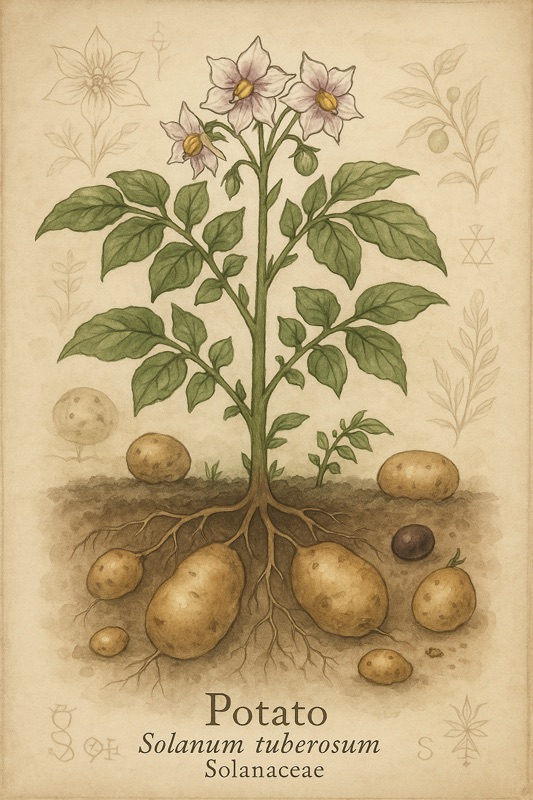
References – Potatoes
- Cunningham, S. (1985). Cunningham’s Encyclopedia of Magical Herbs. Llewellyn Publications.
- European Food Safety Authority (EFSA). (2020). Risk assessment of glycoalkaloids in food and feed. EFSA Journal, 18(8), e06222. https://doi.org/10.2903/j.efsa.2020.6222
- Food and Agriculture Organization of the United Nations (FAO). (2008). International Year of the Potato: Potato facts and figures. http://www.fao.org/potato-2008/en/potato/index.html
- Grieve, M. (1931). A Modern Herbal. London: Jonathan Cape. (Available online via Project Gutenberg)
- Harvard T.H. Chan School of Public Health. (n.d.). Potatoes. The Nutrition Source. https://www.hsph.harvard.edu/nutritionsource/food-features/potatoes/
- Kiple, K. F., & Ornelas, K. C. (Eds.). (2000). The Cambridge World History of Food. Cambridge University Press.
- Salaman, R. (1949/2000). The History and Social Influence of the Potato. Cambridge University Press.
- United States Department of Agriculture (USDA). (n.d.). FoodData Central: Potatoes, raw, flesh and skin. https://fdc.nal.usda.gov/
- University of Maine Cooperative Extension. (2019). Growing Potatoes in the Home Garden (Bulletin #2077). https://extension.umaine.edu/publications/2077e/
- USDA, Natural Resources Conservation Service. (n.d.). PLANTS Database: Solanum tuberosum. https://plants.usda.gov/
- Centers for Disease Control and Prevention (CDC). Solanine poisoning outbreaks.
- https://www.cdc.gov/mmwr/preview/mmwrhtml/00000382.htm
- U.S. Food and Drug Administration (FDA). Bad Bug Book: Solanine and Chaconine.
- https://www.fda.gov/media/83249/download
- European Food Safety Authority (EFSA). Scientific Opinion on Glycoalkaloids in Food and Feed. EFSA Journal, 2020.
- https://www.efsa.europa.eu/en/efsajournal/pub/6222
- World Health Organization (WHO). Food Safety: Glycoalkaloids in Potatoes.
- https://www.who.int/news-room/fact-sheets/detail/food-safety
- U.S. National Library of Medicine / PubChem. Solanine compound record.
- https://pubchem.ncbi.nlm.nih.gov/compound/Solanine
